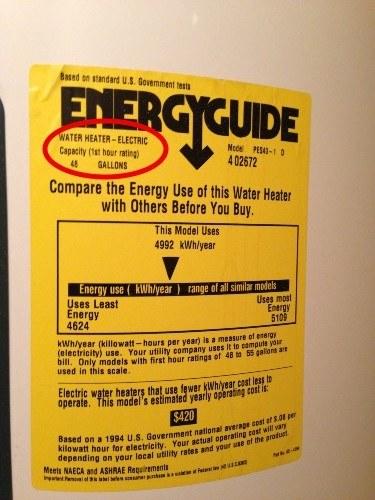What Size Water Heater Do I Need?
In the market for a new water heater?
One thing you’ll need to consider is the “size” of the new unit, which refers to how much hot water the water heater can provide in a given time.
Choosing the right size is important: If you get a water heater that’s too small, you’ll never have enough hot water for all of your appliances. And if you end up with a water heater that’s too big for your household’s hot water needs, it means you overspent on equipment costs.
To avoid those problems, we’ll share how to properly size 2 types of water heaters:
Let’s start by looking at how to size tank water heaters.
Want a professional to size your new water heater for you?
Our highly-trained plumbers can help you choose the perfect water heater for your family’s hot water needs.
How to size a tank water heater
Traditional water heaters store hot water in a tank, which typically holds anywhere from 50 to 80 gallons of water at a time.
Some homeowners assume they can just look at the storage capacity of the tank to know what unit size they need. However, there’s more that goes into sizing a tank water heater.
To find the right tank size for your home, you’ll need to follow 2 steps:
- Calculate your home’s peak hour demand
- Find a tank unit with a matching first hour rating
We’ll explain both of these steps below.
Step #1: Calculate your home’s peak hour demand
Peak hour demand refers to the amount of hot water (in gallons) your household uses during the most demanding hour of the day.
To find your household’s peak hour demand, start by thinking about the time of day your family uses the most hot water at one time. Is it early in the morning, before people head off to work and school? Or is it in the evenings, when everyone is home again?
Next, you’ll want to list all of the hot water appliances your family uses during that time. For example, you might list the following appliances:
- Washing machine
- Shower (possibly 2 showers at one time)
- Kitchen faucet
- Bathroom faucets
- Dishwasher
After you list all of the appliances your family uses during the busiest hour of the day, you’ll need to consider how many gallons each appliance uses. To know how many gallons of hot water common appliances consume on average, you can refer to this peak hour demand worksheet from Energy.gov.
Using our list of appliances from above, this is how many gallons of hot water each appliance consumes on average:
- Washing machine = 7 gallons
- 2 showers = 20 gallons
- Kitchen faucet = 4 gallons
- Bathroom faucets = 4 gallons
- Dishwasher = 6 gallons
In this example, your household’s peak hour demand would be around 41 gallons. After you calculate your household’s peak hour demand, you’ll want to find a tank unit with a first hour rating that matches your peak hour demand.
Step #2: Find a tank unit with a matching first hour rating
A tank unit’s first hour rating will tell you how many gallons of hot water the tank can provide in one hour (starting with a full tank). You can find a tank’s first hour rating on the yellow Energy Guide label, which is printed on the side of the tank.

When you choose a tank unit, the first hour rating should be within 1 or 2 gallons of your home’s peak hour demand. This will ensure your tank will provide sufficient hot water to your home during the time your family needs hot water the most.
For example, if your family’s peak hour demand is 41 gallons (from the example in Step #1), you would need a tank with a first hour rating of at least 40 gallons.
How to size a tankless water heater
Tankless units heat water “on-demand,” instead of storing the hot water in a tank. Because they provide hot water only when you need it, tankless water heaters are generally more energy efficient than tank water heaters.
To size a tankless water heater, you’ll need to follow these 3 steps:
- Calculate your household’s flow rate
- Find the temperature rise for your area
- Choose a tankless unit that matches your flow rate and temperature rise
Step #1: Calculate your household’s flow rate
Flow rate refers to how many gallons of hot water a particular appliance uses per minute.
Below is a list of common hot water appliances with their average flow rates (measured in gallons per minute, or gpm):
- Kitchen faucet: 1.5 gpm
- Bathroom faucet: 1.0 gpm
- Dishwasher: 1.5 gpm
- Washing machine: 2.5 gpm
- Shower: 2.5 gpm
- Tub: 4.0 gpm
To start sizing your tankless water heater, you’ll need to add up the flow rates of all the hot water appliances you imagine your family will use at one time. For example, if you think your family will often use a dishwasher, shower and kitchen faucet at the same time, your household’s flow rate would be 5.5 gpm.
Step #2: Find the temperature rise for your area
After you find your household’s total flow rate, you’ll need to consider the temperature rise for your area.
Temperature rise refers to the difference in temperature between the incoming water and your desired hot-water temperature.
For example, if the incoming water temperature is 70° F, and the thermostat on the tankless unit is set to 120°, the temperature rise would be 50°.
To find the incoming water temperature for your area, you can refer to this groundwater temperature map provided by the EPA.
Step #3: Choose a tankless unit that matches your flow rate and temperature rise
Now that you know the flow rate and temperature rise, you can search for a tankless unit that will match your home’s hot water demand.
Most tankless manufacturers will list the flow rate and temperature rise in the unit’s product specifications. You can find the product specifications for a particular tankless unit by visiting the manufacturer’s website and searching for the unit’s spec sheet.
Want a professional to size your new water heater for you?
Call Michael & Son today. Our highly-trained plumbers can correctly size your water heater, and help you pick the perfect unit for your family’s hot water needs.
Learn about other factors (besides size) you should consider for your new water heater by reading our blog, “How Much Does it Cost to Install a Water Heater?”.
This blog was written on Jan 12, 2021. Any pricing information is subject to change.

